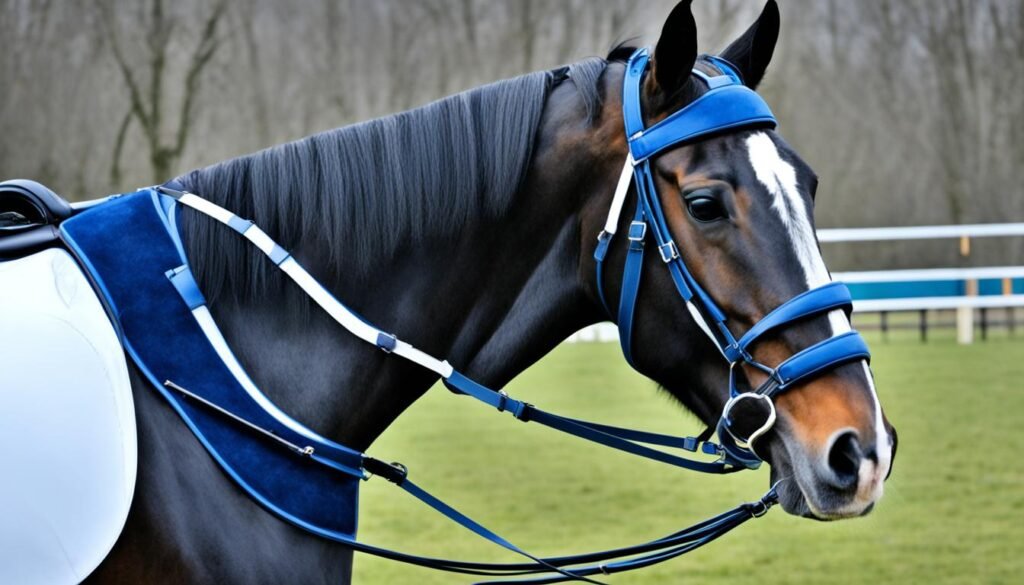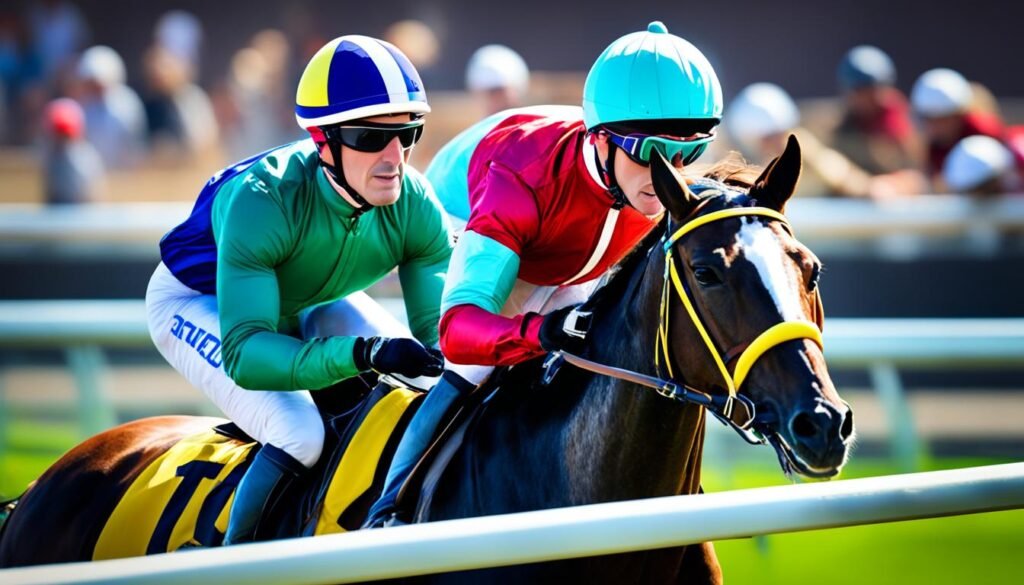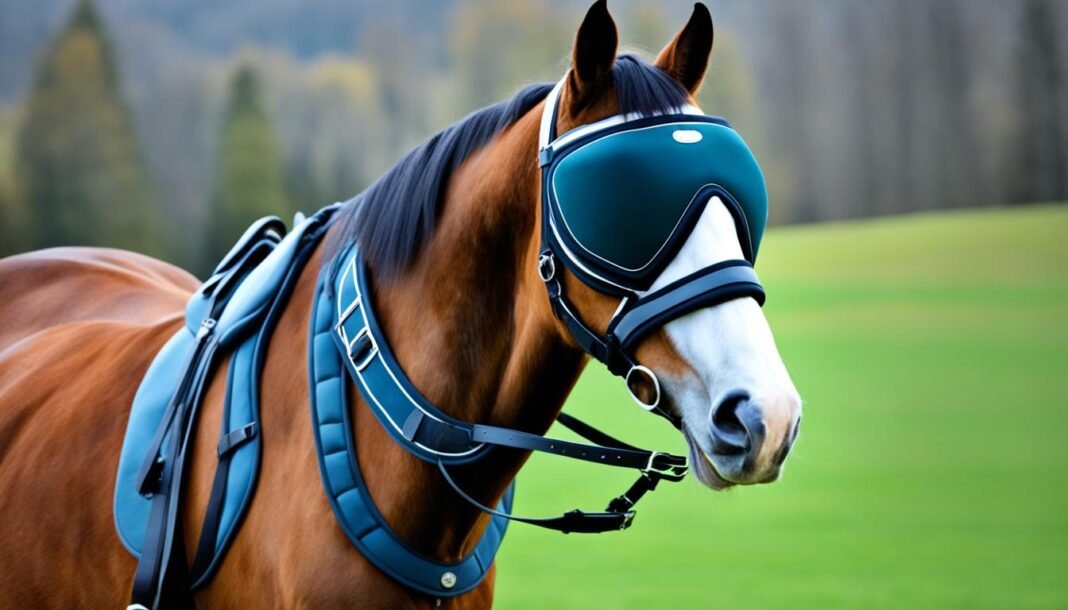Horse blinders, also called blinkers or winkers, are crucial for horse focus and safety. They date back to ancient Roman charioteers1. Over time, blinders evolved from leather patches to metal and fabric1.
The Industrial Revolution brought adjustable and interchangeable blinders. This allowed customization for different horses and activities1. Blinders help horses stay focused in competitive settings like harness racing and show jumping1.
These devices also keep horses and handlers safe in urban areas. They protect against sudden movements or noises that might spook horses1. Blinders are used in various equestrian activities, from racing to agricultural work1.
Let’s dive into the history and function of horse blinders. We’ll explore their impact on horse behavior and welfare. We’ll also look at new designs and alternatives for horses and handlers.
Key Takeaways
- Horse blinders have been used for centuries, with origins dating back to ancient Roman charioteers.
- Blinders help horses maintain focus, particularly in competitive environments like harness racing and show jumping.
- Blinders play a crucial role in ensuring the safety of both horses and handlers, especially in urban settings.
- Blinders are used in a variety of equestrian activities, including harness racing, show jumping, driving, carriage rides, and agricultural work.
- Proper fitting and gradual introduction of blinders are essential for maximizing their benefits and minimizing any negative effects.
The History of Horse Blinders
Ancient Origins
Horse blinders, or blinkers, have been used since ancient times2. Roman charioteers used them to keep horses calm during races2. These tools helped horses focus in chaotic settings.
Blinder designs have changed over time2. They started as simple leather patches on bridles. As we learned more about horses, blinders improved too2.
Evolution Through the Ages
In the Middle Ages, blinders were made of metal and fabric2. This made them stronger and more comfortable. The Industrial Revolution brought adjustable and customizable blinders2.
Today, there are many blinder designs for different needs3. Some limit two-thirds of a horse’s vision. Others, like French cups, offer varying degrees of restriction3.
“Blinkers, also known as blinders, are a piece of horse tack that prevent the horse from seeing to the rear and, in some cases, to the side.”2
Horse blinders come in many forms3. Shadow rolls, winkers, and carriage harness blinders all serve unique purposes. Each type helps horses in different settings.
Blinders have stood the test of time23. They continue to keep horses safe and focused. Their ongoing development shows how important they are in equine care.
The Purpose of Horse Blinders
Horse blinders, or blinkers, are crucial in equine management. They help horses focus better4. Horses have a wide 350-degree field of vision due to their eye position4. This can lead to distractions, especially in competitions.
Blinders limit a horse’s vision to improve focus4. Some racing blinders can restrict vision by 30 to 180 degrees4. This prevents horses from getting startled, helping them concentrate on their performance.
Enhancing Focus and Concentration
Horse blinders are common in equestrian sports like harness racing and show jumping4. Very restrictive blinders may cause horses to feel claustrophobic4. This can lead to a quick start but early exhaustion in races.
Blinders can also protect horses’ eyes during injury recovery4. If you see a horse wearing a mask in a field, it’s likely a fly mask4. These protect against insects, not for vision restriction.
Horse blinders are essential equine equipment that boost focus and concentration5. Modern blinders evolved around the 1600s5. They became standard for racing and driving in Europe by the late 1800s.
| Blinder Type | Description |
|---|---|
| Full Cup | Provides the most restrictive vision, covering the entire eye area. |
| Standard Blinder | Covers the sides of the eye area, allowing some peripheral vision. |
| French Cup | Covers the top and sides of the eye area, with a more open design. |
| Cheater Cup | Provides a slightly less restrictive vision than the Full Cup. |
| Semi-Cup | Covers the top of the eye area, allowing more peripheral vision. |
Each blinder type serves a specific purpose in enhancing horse focus5. Understanding these designs helps professionals make informed decisions. They can optimize their horses’ performance and well-being with the right choice.
“Blinders are less commonly used in European horse racing compared to the USA, with cheekpieces becoming more popular in Europe.”5
The equestrian world keeps evolving, along with its technologies and techniques. Horse blinders remain vital for equine excellence. They showcase the dedication to bringing out the best in these amazing animals45.
Horse Blinders in Competitive Equestrian Sports
Horse blinders are vital in equestrian sports. They help horses focus during intense competition moments. From harness racing to show jumping, these devices play a crucial role.
Harness Racing
Horse blinders are essential in harness racing. Made from lightweight materials, they limit the horse’s peripheral vision6. This helps horses concentrate on the racetrack, avoiding distractions from crowds or other horses.
Blinders are key to maximizing a horse’s speed and performance. Even slight distractions can make the difference between winning and losing6.
Show Jumping
Blinders are crucial in show jumping too. Horses must navigate complex obstacles with precision and agility7. In this sport, blinders are often adjustable.
Trainers can customize vision restriction based on each horse’s needs7. This helps horses focus on jumps and avoid dangerous missteps.
Blinders keep horses’ attention on the course. This improves safety for both horse and rider.
However, blinder use in equestrian sports isn’t without controversy8. Some view horses as tools for ego or financial gain. This approach prioritizes control over empathy.
Critics call for a shift in the industry. They want more focus on horse-human relationships. Equestrian pursuits offer unique chances to teach empathy8.
Blinders remain important in many equestrian disciplines. They help horses focus and perform well. The industry must balance competition needs with ethical animal treatment.
Horse Blinders in Non-Competitive Settings
Horse blinders are useful in various non-competitive settings. They help ensure safety and focus for our equine friends. These accessories are vital in driving, carriage rides, and agricultural work.
Driving and Carriage Rides
Blinders are crucial for horses in driving or carriage rides. They keep horses safe in busy urban areas. Made of tough leather or synthetic materials, blinders shield horses from distractions.
They limit peripheral vision, helping horses focus on the road ahead. This prevents startling from pedestrians or traffic9. Blinders improve the experience for passengers and benefit the horse’s well-being.
Agricultural Work
Blinders are essential for horses plowing fields or pulling carts. Farm work demands sturdy blinders made from heavy-duty materials9. These blinders help horses stay calm and steady during tough tasks.
By reducing side vision, blinders improve focus and lower accident risks10. This leads to better productivity and a safer work environment for horses and farmers.
| Setting | Purpose of Blinders | Blinder Design |
|---|---|---|
| Driving and Carriage Rides | Maintain focus, prevent startling | Durable leather or synthetic materials |
| Agricultural Work | Maintain calm, improve focus | Robust, heavy-duty materials |
Horse blinders are key in cities and on farms. They ensure safety and focus for these amazing animals. Blinders help horses stay on task and reduce accidents91110.
Impacts of Horse Blinders on Behavior
Horse blinders can affect equine behavior in various ways12. Trainers and handlers often use blinders, blinkers, or winkers on 80-90% of horses12. This practice dates back centuries, with leather squares obstructing horses’ rear vision12.
Racing trainers use eye cups in hoods to change horse behavior12. They may cut holes in the back to make horses sense competitors behind them12. Secretariat, a famous racehorse, wore trademark blue and white blinkers12.
Positive Effects
Blinders help horses focus, boosting performance in competitions and work13. They’ve been used in racing since the 18th century13. Limiting peripheral vision can improve race performance13.
Jockeys report that blinders make horses more determined during tough moments13. Nervous horses may feel safer and more confident with fewer distractions13.
Potential Negative Effects
Improper use of blinders can lead to over-reliance, sensory deprivation, and behavioral issues12. Some believe blinkered horses perform worse on wet tracks due to eye cup obstruction12.
Blinkers have been used on humans in specific cases12. For example, ultraorthodox Jewish men used spectacle stick-ons to avoid “impure” images12. This may blur vision rather than restrict the field of view12.
Horses used to blinders may struggle without them13. Long-term use can affect their ability to process environmental cues13. Studies on racing horse blinders show mixed results13.
Alternatives to blinders include desensitization training, earplugs, and calmer riding styles13. Ethical considerations in horse racing are crucial for animal welfare and industry standards13.
Proper Fit and Use of Horse Blinders
Horse blinders are vital for your equine friend’s safety and performance. They come in various designs for different needs. Selecting the right type is crucial for your horse’s comfort.
Introduce blinders slowly to help your horse adjust. This prevents negative effects and keeps your horse at ease. Gradual introduction ensures your horse stays focused during activities.
- Ensure a snug but comfortable fit, allowing for some movement without the blinders slipping or causing discomfort14.
- Regularly monitor your horse’s behavior and performance to make adjustments as needed15.
- Consider alternative options, such as using a race hood with half cup blinders, if your horse requires a more moderate level of vision restriction15.
Proper fit is key to maximizing blinder benefits. It ensures your horse’s safety and well-being. Stay aware of your horse’s needs for the best results.
| Bridle Adjustment | Proper Fit Guideline |
|---|---|
| Throatlatch | Snug to prevent slippage, but not too tight to choke |
| Curbchain | Allow two-finger space for comfortable fit |
| Bit Width | Crucial to avoid pinching the lips |
| Breastcollar | Positioning affects breathing and range of motion |
| Backsaddle | Should not touch the back, space needed between tree and backbone |
| Bellyband or Girth | Allow passage of one finger for proper fit |
| Breeching | Correct adjustment important for braking downhill |
| Straps | Should fit snugly, not too tight to avoid girth sores |

Proper fit and slow introduction are key for your horse’s comfort. Follow these tips for a safe experience. Your horse’s needs should always come first when using blinders151416.
Innovative Designs and Alternatives
Equestrian sports are constantly evolving, along with their tools and equipment. Innovative horse blinder designs17 have emerged from new materials and technology. Modern blinders offer comfort, durability, and customizable vision restriction.
Some use lightweight, breathable materials for enhanced comfort. Others feature adjustable panels or lenses to tailor vision restriction. These designs cater to specific horse needs and tasks.
Modern Materials and Technology
Alternatives to traditional horse blinders are gaining popularity18. Some trainers use noise-canceling earplugs or soundproof hoods to reduce distractions. These options don’t restrict vision but still help horses focus.
Other trainers focus on desensitization and habituation techniques. These methods help horses naturally cope with distractions without using physical aids.
Training Techniques and Other Alternatives
Panasonic and Kunihiko Morinaga created an innovative solution called the Wear Space device19. This device costs 29,800 Japanese Yen ($260) and features noise-canceling headphones.
Wear Space offers three noise cancellation levels and Bluetooth compatibility. It’s designed to boost focus in modern workplaces, adapting to various environments.
Innovative horse blinder designs and modern materials are transforming equestrian gear171819. These advancements prioritize safety and performance, offering new options for horse owners and trainers.
“Successful modern manufacturers who lead without blinders, embrace new technologies, and modify strategies tend to achieve repeated success in the industry.”17
Choosing the Right Horse Blinders
Picking the right horse blinders is vital for your equine friend’s safety and performance. The choice depends on the activity and your horse’s specific needs20.
Vision restriction is a key factor to consider. Racing horses may need more restrictive blinders for better focus. Trail riding horses might benefit from less restrictive options for better awareness20.
Your horse’s temperament matters too. Some horses respond better to certain blinder designs than others.
| Factor | Considerations |
|---|---|
| Vision Restriction | Harness racing: More restrictive blinders Trail riding: Less restrictive blinders |
| Horse Temperament | Responsive to specific blinder designs |
| Environment | Suitability for the intended riding or working conditions |
The riding environment is crucial too. Show blinders might not work well for trail riding’s uneven terrain. Ask a pro for help choosing the best blinders for your horse20.
Proper fit is key. Blinders should be snug but not tight. They should allow some movement without slipping or causing discomfort21.
Watch your horse’s behavior and performance. Make adjustments as needed to ensure the blinders are working well.
By weighing these factors and getting expert advice, you’ll pick great blinders. They’ll boost your horse’s focus, safety, and overall performance2021.
Horse Blinders: Ensuring Safety and Welfare
Horse blinders require careful thought and understanding. Handlers must choose the right type and fit to maximize benefits. Monitoring effects is crucial for the horse’s welfare22.
Introduce blinders gradually to prevent over-reliance or sensory deprivation. Check for signs of irritation or stress regularly. Make adjustments as needed to keep horses comfortable22.
Seek advice from equestrian pros for safe and effective blinder use. This helps improve safety and performance for horses and handlers22.
Considerations for Horse Blinder Use
- Most racehorses wear blinders with tiny cups to block peripheral vision. This helps them focus and reduces distractions22.
- Horse-drawn carriages use blinders to prevent spooking. This ensures safety for the horse, passengers, and bystanders22.
- Draft horses on farms wear blinders to avoid startling. This protects them from farm equipment, animals, or shadows22.
- Racehorses wear blinders to stay focused on the track. This reduces accidents during races22.
- Blinders can help horses recover from eye injuries. They block harmful light and prevent scratching22.
- Some horses don’t benefit from blinders in races. Trainers must decide based on the horse’s behavior22.
Understanding horse behavior is key to managing distractions. Blinders help horses focus forward in busy environments. This reduces spooking from side movements22.
Blinders boost focus during racing and carriage driving. This ensures safety for both horses and handlers22.
Iqraash puts horse welfare first in equipment design. They focus on comfort and freedom of movement. They blend old-school craftsmanship with new tech for top-quality gear22.
“Ensuring the safety and well-being of our horses is our top priority. We strive to develop equipment that enhances their focus and performance while prioritizing their comfort and natural behaviors.”

| Advantage | Disadvantage |
|---|---|
| Reduces distractions and enhances focus | Potential for sensory deprivation and behavioral issues |
| Improves safety during competitive events and carriage rides | Requires careful monitoring and gradual acclimation |
| Can aid in recovery from eye injuries | Some horses may not benefit from blinder use |
Using horse blinders responsibly is crucial for safety. Understanding blinder use and seeking expert advice helps. This ensures the well-being of horses and handlers22.
Conclusion
Horse blinders are vital in the equestrian world. They offer focus, safety, and performance benefits23. By limiting a horse’s vision, blinders help riders maintain control and boost the animal’s potential23.
However, using blinders requires careful thought. They can enhance focus but may limit a horse’s ability to perceive threats23. Handlers must choose the right type and ensure proper fit.
Monitoring the horse’s behavior and welfare is crucial. Innovations in equestrian gear promise new possibilities for horse-handler relationships24. The principles behind blinders may apply to improving focus in various settings24.
Responsible use of horse blinders can boost safety and performance. It can also enhance the well-being of horses and their human partners. This approach contributes to a thriving equestrian community.

